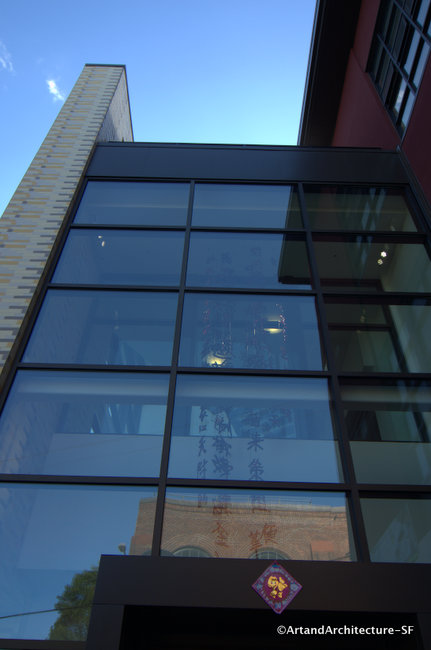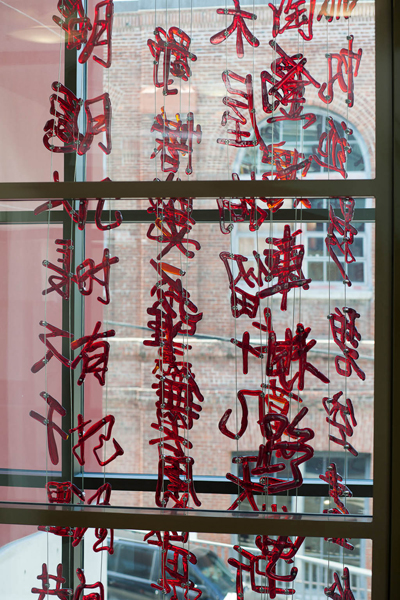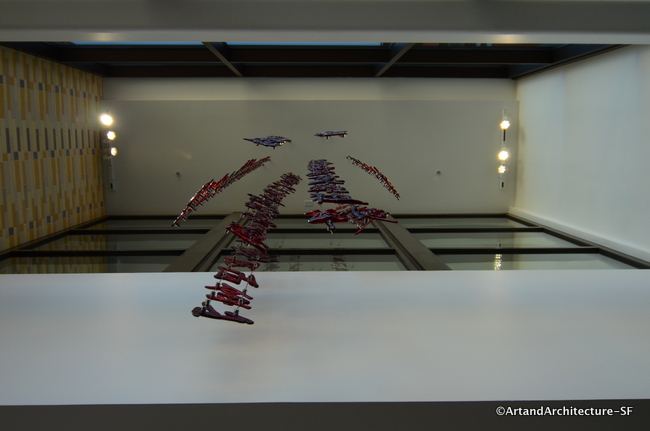1199 Mason at Washington
Chinatown
This is the entry to the Betty Ong Recreation Center in Chinatown. Betty Ann Ong was a flight attendant on American Airlines, Flight 11, the first airplane to become hijacked on September 11, 2001. Shortly after the hijacking began, Betty chose to be involved and make a difference by taking action to notify the American Airlines ground crew of the hijacking situation on board the airplane. Amid horrific danger, she stayed on the telephone for 25 minutes, relaying vital information that eventually led to the closing of airspace by the FAA for the first time in United States history.
In memory of Betty, the Betty Ann Ong Foundation, a not for profit public charity, was established to continue her legacy. The advocacy of the Betty Ann Ong Foundation serves to educate children to the positive benefits of lifelong physical activity and healthy eating habits and to provide opportunities for children to experience the great outdoors so that they can grow to become healthy, strong and productive individuals.
For the center’s entrance lobby, Chinese-born Shan Shan Sheng created a suspension sculpture that uses language to speak to the unique Chinese American experience in San Francisco and the California landscape. Active Memory is cascade of red Chinese calligraphy that showers visitors upon entry. The artist handmade the glass characters so that they look handwritten. The sculpture’s form, vertical flows of narrative, was inspired by traditional Chinese landscape paintings, which are often inscribed with poems. The sculpture itself is comprised of five poems, two of which are by renowned poets Bai Juyi (772-846) and Li Bai (701-762) of the Tang Dynasty and a poem by Su Shi (1036-1101) of the Song Dynasty. The other poems include an early twentieth-century poem by an anonymous immigrant about his experience on Angel Island and the last by the Artist, with key words describing the lives of Chinese immigrants in the Bay Area, Words such as “gold rush”, “railroad track”, and “computer” invoke the memory of travel, labor and the transformation of America.
Strands 1/2, Tang Dynasty poet Bai Juyi (772‐846)
唐 白居易 《賦得古原草送別》 離離原上草,一歲一枯榮。 野火燒不盡,春風吹又生。
“Grasses on the Ancient Plain: A Farewell Song”
The grass is spreading out across the plain,
In spring it comes and by fall it goes.
Wild fire cannot destroy it all;
When spring winds blow it surges back again.
Strand 3, Tang Dynasty poet, Li Bai (701‐762) 唐 李白 《送孟浩然之廣陵》
孤帆遠影碧空盡,惟見長江天際流。
“A Farewell To Meng Haoran On His Way To Yangzhou”
Under the blue sky, your lonely sail turns into a silhouette, Only the long river rolls on its way to heaven.
Strands 4/ 5, Song Dynasty poet, Su Shi (1036‐1101)
宋 蘇軾 《水調歌頭》 明月幾時有,把酒問青天。 但願人長久,千里共嬋娟。
“Thinking of You”
With a cup of wine in hand, I look at the sky
and wonder when the moon first appeared.
May we all be blessed with long life.
We can still share the beauty of the moon together even if we are thousand miles apart.
Strands 6/7, Anonymous poem from the book Island: Poetry and History of Immigrants on Angel Island, 1920‐1940, by Him Mark Lai, Genny Lim and Judy Yung
天使島牆詩 木屋拘留幾十天,所囚墨例致牽連,可惜英雄無用武,只聽音來策祖鞭
Detained in this wooden house for several tens of days.
It is all because of the Mexican exclusion law which implicates me.
It’s a pity that even if a hero has no way to exercising his prowess here.
The only thing we can do to get us out of this place fast is to wait for the call.
Translator’s note No. 1: 策[ce]:take; snap. 祖鞭[zu bian]:be in front; in lead; stay on top. 策祖鞭(take Zu’s whip) in general means doing something in the lead.]
Translator’s note No. 2: The translator modified the wording in the last two lines of the English translation to provide clearer meaning.
Strand 8, Keywords related to Chinese immigrants history in the San Francisco Bay Area by the Artist
淘金 火車鐵路 半導體數碼 電腦 網路舊金山
Gold rush, train, railroad track, Semi conductor, digital age, computer, network, San Francisco
Shan Shan Sheng grew up during the Cultural Revolution. In 1982 she came to the US to pursue her academic and artistic interests by attending Mount Holyoke College and the University of Massachusetts at Amherst where she earned her first MFA. She then went on to Harvard as an artist-in-residence for two years. She now lives in San Francisco.



Wonderful! It must have been so difficult to do the calligraphy in fused glass.
Love the suspended sculpture, it’s fantastic!